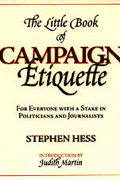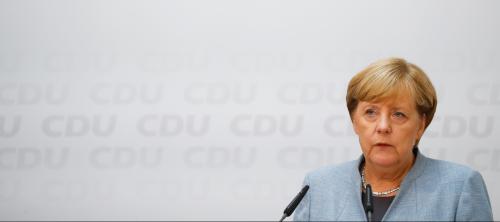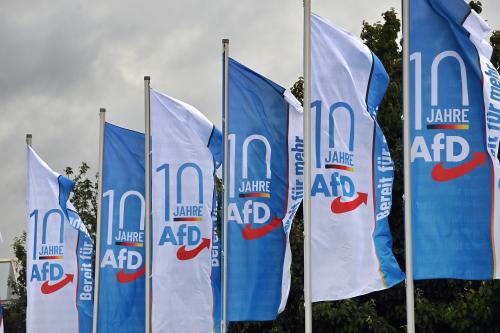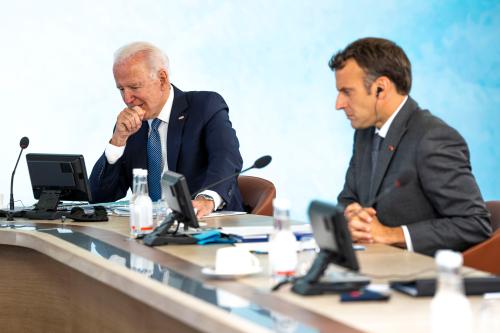It is often easier to diagnose a friend’s problem than to address one’s own. In Germany, many people are more interested in talking about Donald Trump—now a year out from his election victory—and divisions within American society than the reasons a far-right party is entering the federal parliament for the first time in over half a century. It seems Germans—unlike many Americans—have not yet begun working through the five stages of grief. Rather, they are still in the denial phase.
Dramatic as populism’s march across the West has been, national experiences vary. In the United States, the debate has focused on identity, race, and economic disparities. In Germany, it has centered on identity, religion (sometimes used as a cover for race), and loss of state control. Yet both countries are witnessing internal struggles in response to globalization: Is it a reality to be accepted given the benefits of free trade and greater mobility, or a danger to be resisted given its importation of “the other” and threat to state sovereignty? In grappling with this question, Germany should recall how an initially small movement in the United States fundamentally altered the conversation.
The Alternative for Germany (AfD) party emerged in 2012 during the European financial crisis. Its founders, primarily drawn from the Christian Democratic Union (CDU) party led by Chancellor Angela Merkel, were center-right conservatives and soft euroskeptics. They disliked Merkel’s shift toward the political center and decision to use German taxpayer money to bail out other eurozone members. The AfD narrowly failed to win seats in the 2013 national elections, but it found a new voice in 2015 amid the arrival of a million refugees and migrants. That summer, a power struggle within the party pitched the founders who focused on economic policy against a faction advocating a hardline, nationalist approach; the latter won. The AfD’s new leadership adopted a more populist and xenophobic tone that prioritized immigration, domestic security, and challenges to national sovereignty from European integration and refugees.
In the September 24 elections, the AfD attracted nearly 6 million votes (12.6 percent) and entered parliament for the first time as the third largest party. It didn’t appeal simply to a right-wing fringe. It received support across party lines: a million votes from the Chancellor’s CDU; 500,000 votes from the Social Democrats; and 400,000 from supporters of the post-communist Left Party. In addition, 1.2 million votes came from those who stayed home in past elections. The AfD responded to voters’ anxiety about the refugee crisis by blaming state failure and fueling anti-Muslim sentiment. Its leader vowed to “take back our country and our people,” as the party scorned the political establishment and political correctness.
The trajectory of the AfD bears similarities to the Tea Party movement in the United States. Both were born from center-right frustration with perceived misuse of taxpayer money. The Tea Party emerged from conservative anger over increasing debt and federal spending. In particular, its adherents opposed auto industry and financial sector bailouts begun during the Bush administration followed by a stimulus package and health care reform enacted by a Democrat-controlled Congress and White House. As with the AfD’s shift from economics to immigration, the Tea Party’s initial focus on financial issues was co-opted by advocates of conservative social policies (e.g., opposition to abortion and gay marriage).
The Tea Party elevated the profile of individuals and issues previously consigned to the right-wing fringe. Its first targets were incumbent Republicans seen as too liberal. The movement gained power in the 2010 mid-term elections, when Republicans swept Democrats from the House of Representatives and Tea Party-endorsed politicians took office. The activism of the new House Freedom Caucus left Speaker John Boehner unable to pass traditionally Republican-backed legislation and limited his ability to reach compromise with Democrats. There is a similar risk the AfD could shift political discourse to the right and force mainstream parties to adopt harder line positions (especially on Europe and immigration). In addition, the party’s less extreme members could leave (as already seen with one leader’s decision to serve as an independent) and be replaced by more radical advocates.
There are limits to this comparison. The AfD began as an elite-driven political party, while the Tea Party was a grassroots movement that benefited from wealthy donors and right-wing media support. The AfD, which is politically inexperienced and lacks internal discipline, remains a small opposition party in a parliamentary system. And while the values undergirding the Tea Party gained voice in the White House with Donald Trump’s election, the movement is not the sole factor for his success.
And yet it would be a mistake to under-estimate the influence of populist voices in national discourse and the reasons for their broad-based appeal. While German sympathy for America’s internal divisions is appreciated, the reality is that our countries are facing similar trials. The main difference is the United States has a year-long head start on working through the stages of grief, with many hovering between anger, bargaining, and depression depending on the day. We’re both far from acceptance.









Commentary
Populist electoral gains: The five stages of grief
November 7, 2017